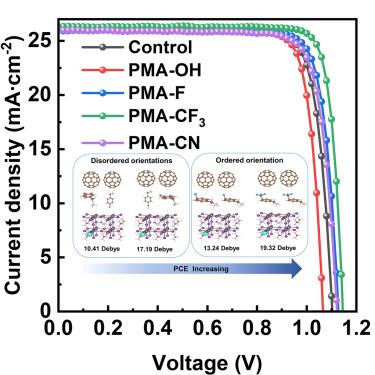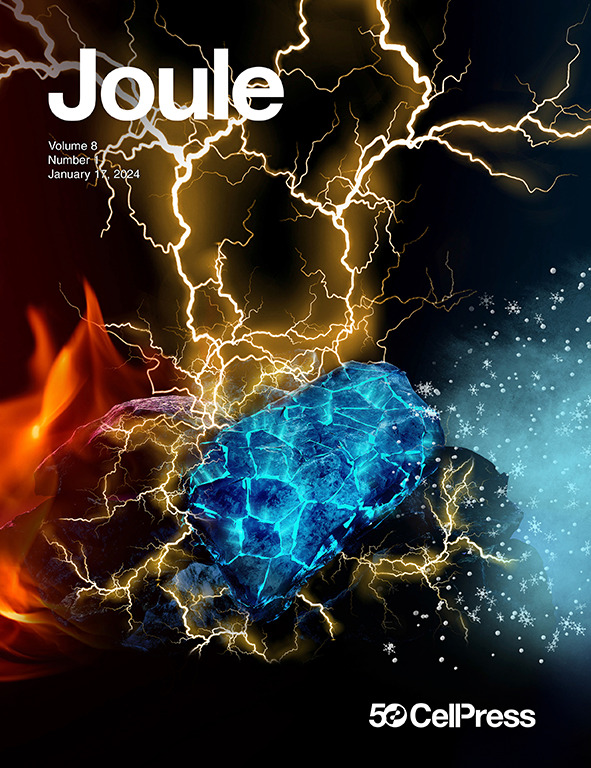高效稳定的钙钛矿太阳能电池的可调分子偶极矩和取向
IF 35.4
1区 材料科学
Q1 CHEMISTRY, PHYSICAL
引用次数: 0
摘要
具有正负两端的分子被称为偶极分子,是钙钛矿界面修饰的有效工具。然而,它们的偶极矩、系统的整体极性和它们的方向的影响仍未被探索。在这项工作中,我们设计了四种具有不同供/吸电子基团的分子,从而产生不同的偶极矩和取向,并分析了它们作为钙钛矿薄膜表面改性剂对性能的影响。偶极矩最大、有序平行取向的(4-(三氟甲基)苯基)甲基碘化铵(PMA-CF3)处理后的钙钛矿与C60的能级匹配程度最高,有利于界面电子传递,阻碍了界面空穴输运。经PMA-CF3处理的冠军器件表现出最佳性能,功率转换效率为26.04%(经认证的最大功率点跟踪350秒的稳态效率为25.62%),并且具有良好的存储和光浸泡稳定性。本文章由计算机程序翻译,如有差异,请以英文原文为准。


Tunable molecular dipole moments and orientations for efficient and stable perovskite solar cells
Molecules with positive and negative ends, known as dipolar molecules, are effective tools for the interfacial modifications of perovskites. However, the impact of their dipole moments, the system’s overall polarity, and their orientations remains unexplored. In this work, we designed four molecules with different electron-donating/withdrawing groups, resulting in varying dipole moments and orientations, and analyzed their impact on performance when applied to perovskite films as surface modifiers. The perovskite treated with (4-(trifluoromethyl)phenyl)methanaminium iodide (PMA-CF3), which has the largest dipole moment and ordered parallel orientation, exhibited the most matched energy level with C60, which facilitated the electron transport and hindered the hole transport at the interface. The champion devices treated with PMA-CF3 exhibited the best performance with a power conversion efficiency of 26.04% (a certified steady-state efficiency of 25.62% for 350s maximum power point tracking) and excellent storage and light soaking stability.
求助全文
通过发布文献求助,成功后即可免费获取论文全文。
去求助
来源期刊

Joule
Energy-General Energy
CiteScore
53.10
自引率
2.00%
发文量
198
期刊介绍:
Joule is a sister journal to Cell that focuses on research, analysis, and ideas related to sustainable energy. It aims to address the global challenge of the need for more sustainable energy solutions. Joule is a forward-looking journal that bridges disciplines and scales of energy research. It connects researchers and analysts working on scientific, technical, economic, policy, and social challenges related to sustainable energy. The journal covers a wide range of energy research, from fundamental laboratory studies on energy conversion and storage to global-level analysis. Joule aims to highlight and amplify the implications, challenges, and opportunities of novel energy research for different groups in the field.
 求助内容:
求助内容: 应助结果提醒方式:
应助结果提醒方式:


